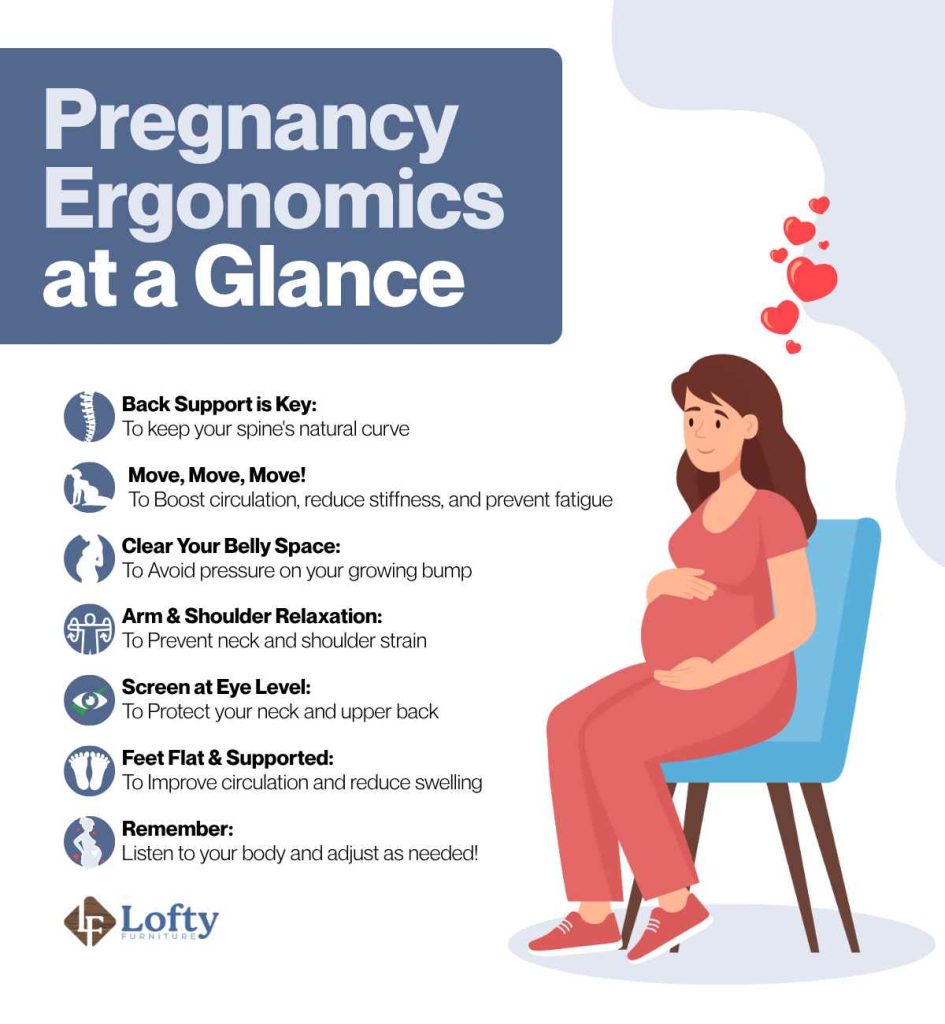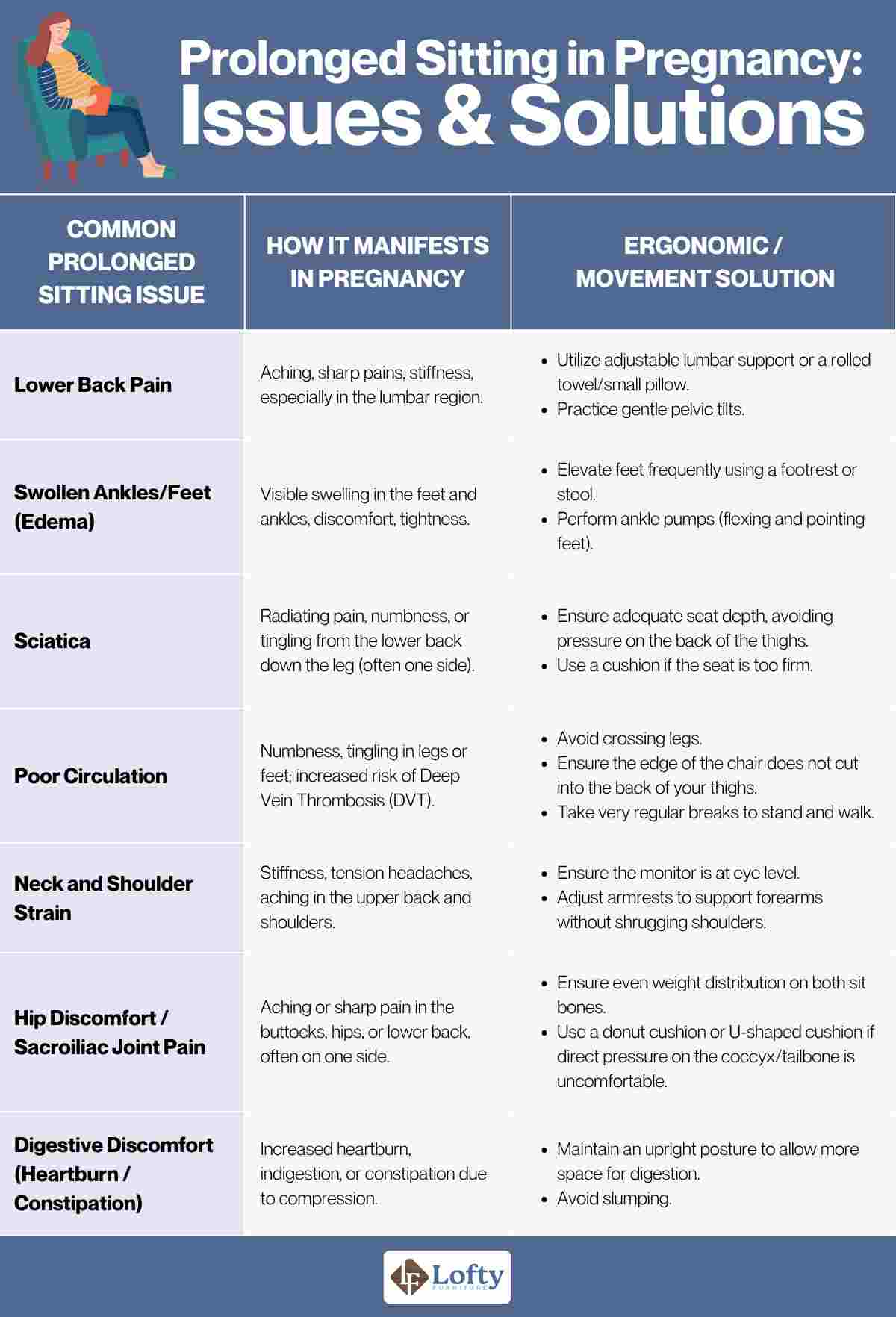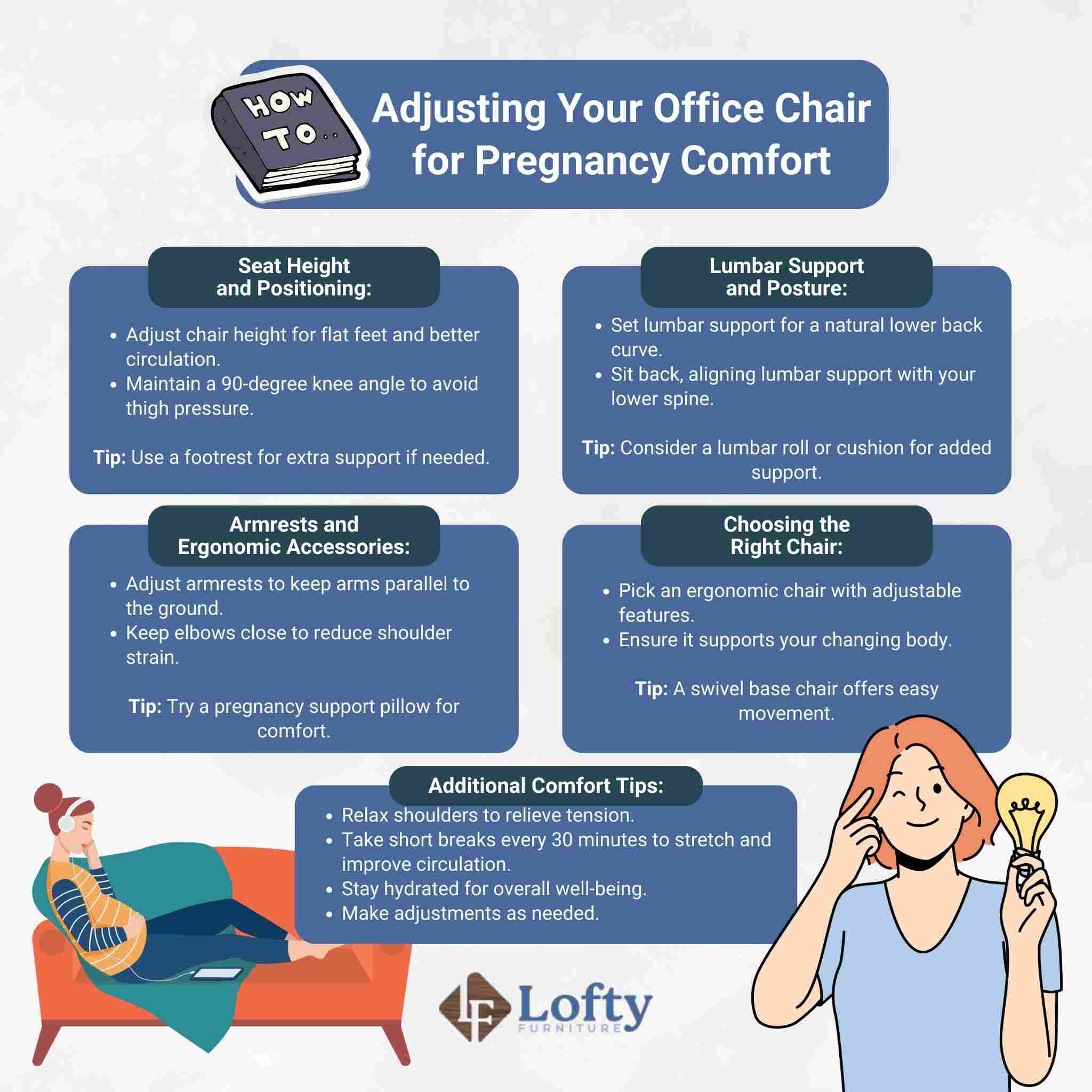Sitting at a desk all day is challenging enough, but when you’re pregnant, it can feel like a whole new level of discomfort. From lower back strain to swelling and fatigue, the way you sit in your office chair matters more than ever. If you’re navigating work while growing a baby, knowing how to sit properly during pregnancy isn’t just about staying comfortable; it’s about supporting your health and your baby’s too.
Key Takeaways:
- During pregnancy, sitting in an office chair requires comfort and support.
- To sit in an office chair during pregnancy, keep your back straight with good posture, use lumbar support, adjust the chair height so your feet are flat, and take regular breaks.
- Listen to your body. Adjust your setup based on what feels comfortable and supportive.
In this article, we will guide you on how to sit properly in your office chair during pregnancy, ensuring a safe and supportive posture. Additionally, we will address specific concerns such as swollen feet and legs, pelvic pain, and sciatica.
Pregnancy and Ergonomics
When you are pregnant, your body goes through various changes that can affect your posture and body mechanics. These changes may include a shift in your center of gravity and an increase in the curvature of your spine.
Practicing good ergonomics during pregnancy is essential for several reasons: it helps reduce discomfort, prevents musculoskeletal injuries, and supports better balance and stability as your body adapts. Proper ergonomics can also lessen fatigue, improve circulation, and make it easier to perform daily activities safely. Whether you are sitting at a desk, lifting objects, or standing for extended periods, using the right posture and supportive equipment can protect both your health and your baby’s well-being throughout pregnancy.

Why Sitting Feels Different During Pregnancy (and Why It Matters)
Pregnancy transforms nearly every part of your body. These changes, while natural, significantly affect how you move and feel, especially when sitting. One of the most common adjustments is an exaggerated curve in the lower spine, called lumbar lordosis, which often leads to leaning backward while seated. At the same time, your body is producing relaxin, a hormone that loosens joints to prepare for childbirth.
As Dr. Sean Ormond, a dual board-certified expert in Anesthesiology and Interventional Pain Management, explains:
“Pregnancy shifts everything—your belly grows, your balance changes, and your joints loosen up. So even sitting, something that used to feel totally fine, can start to feel off. You might notice more pressure in your lower back or swelling in your legs and feet. That’s because your body is working hard to carry extra weight and keep you stable. Sitting the right way can help you stay more comfortable and avoid some of that daily wear and tear.”
But sitting during pregnancy is also about protecting your overall health. Prolonged sitting has been associated with increased risks of gestational diabetes, excessive weight gain, and high blood pressure. It can also slow down blood circulation, leading to swollen legs and exacerbated back pain.

Negative Effects of Improper Sitting During Pregnancy
Sitting with poor posture while pregnant can do more danger than many realize. It can aggravate existing discomforts and even create new ones. As your body compensates for added weight and shifting alignment, bad sitting habits can intensify strain on your lower back, neck, and shoulders—especially if you’re already dealing with sciatica or pelvic girdle pain.
Poor posture also impairs circulation in your legs, increasing the risk of varicose veins or, in rare cases, deep vein thrombosis (DVT). According to Dr. Ormond:
“When your posture’s off—like if you’re slouching, leaning forward, or crossing your legs for too long—it can cause a bunch of problems. Lower back pain, hip discomfort, and even nerve pain (like sciatica) can flare up. Poor circulation can also lead to swollen ankles and feet. Over time, these small things add up and make your body feel even more tired or achy than it needs to be.”

Building the Perfect Sit
To build the perfect sitting position during pregnancy, start by adjusting your seat height and positioning to ensure optimal comfort and support. Pay special attention to maintaining proper lumbar support and posture, which can significantly reduce back pain and discomfort.

Seat Height and Positioning
Adjust your chair so your feet rest flat on the floor, your knees form a 90-degree angle, and your thighs stay parallel to the ground; this setup helps improve circulation and reduces leg swelling. Sit all the way back in the chair so your back is supported, and avoid leaning forward or slouching, which can strain your lower back. Make sure your armrests are at a height that allows your arms to relax while you work.
Lumbar Support and Posture
Supporting your lower back is essential as your belly grows and your posture shifts. Use a chair with built-in lumbar support or add a cushion behind your lower back to maintain alignment and ease back pain. Sit upright with your back fully against the chair, keep your feet flat, and avoid leaning or slouching to stay comfortable and supported.
Armrests and Ergonomic Accessories
Keep armrests adjusted so your shoulders stay relaxed and your arms are supported during tasks. Add a footrest if needed to encourage circulation and reduce swelling. For your wrists, a soft rest can help you maintain a neutral typing position. Also, make sure your keyboard is at elbow height and your chair’s backrest supports your spine’s natural curve.
Choosing the Right Chair for Comfort and Safety
When you are pregnant, it is essential to find a chair with a pregnancy-friendly design. Look for comfortable chairs such as plush cushioning and padded armrests. These features provide support and reduce pressure on your body.
Adjustable options are also important. They allow you to customize the chair’s height and tilt according to your needs. Proper body alignment is crucial during pregnancy, so choose a chair that promotes good posture. Look for one that offers lumbar support and an adjustable backrest. These features will help alleviate any back pain or discomfort you may experience.
Remember, sitting for long periods can be challenging during pregnancy. However, selecting the right chair with these features can make all the difference in ensuring your comfort and safety throughout the day.
Experience unparalleled comfort during your pregnancy with the perfect office arm chair designed to support expectant mothers and transform your workday.
How To Sit in Office Chair During Pregnancy
Ensure your office chair is adjusted for optimal comfort and support during pregnancy. Pregnancy can bring discomfort and changes in your body, making it essential to take extra care when sitting for extended periods.
To maintain a healthy posture, consider the following pregnancy sitting positions:
Step 1: Sit straight with your back against the chair, avoid crossing your legs as it can restrict blood flow, and keep both feet flat on the floor or use a footrest if needed.
Step 2: Adjusting office chair correctly prevents back pain and maintains proper blood circulation. Adjust the seat height so your feet are firmly planted on the ground. This will help distribute weight evenly and prevent strain on your lower back.
Step 3: Adjust the backrest angle to support the natural curve of your spine while providing stability. Additionally, consider using a lumbar pillow or cushion for added support.
Remember to take regular breaks from sitting by standing up and stretching every hour or so. This helps improve blood circulation and reduces swelling in your legs and feet.
Lastly, listen to your body’s signals – if you experience discomfort or pain while sitting, adjust accordingly. Dr. Ormond emphasizes:
“Pick a chair that gives you good back support, and sit all the way back so your spine is supported. Add a pillow or cushion if your lower back needs extra help. Keep your feet flat and try not to cross your legs. Your knees should be bent at about 90 degrees. Try to sit tall, keep your shoulders soft, and take breaks often to stretch or move around a bit. The goal is to keep your body supported but relaxed—it really makes a difference by the end of the day.”
Here is a video you can also use as a reference to make sitting in office chairs more comfortable during pregnancy:
How to Sit in Office Chair During Pregnancy: Beyond the Basic Sit
To go beyond the basic sit in your office chair during pregnancy, it is important to incorporate exercises and stretches that promote comfort. Regular breaks and movement are crucial for improving circulation and reducing discomfort.
Exercises and Stretches for Office Chair Comfort
Sitting for long periods during pregnancy can be made more comfortable by adding simple stretches and exercises to your routine. Gentle neck rolls and shoulder shrugs help release upper-body tension, while pelvic tilts strengthen your core and improve stability. Stretching your legs and ankles — through ankle rolls or by extending your legs and flexing your feet — can prevent swelling and cramping. Incorporating deep, steady breathing also promotes relaxation and better posture.
Regular Breaks and Movement
Frequent movement throughout the day supports circulation, reduces stiffness, and helps prevent discomfort during pregnancy. Even a few minutes of stretching or walking each hour can ease muscle tension and improve focus. Staying active during work hours also boosts energy and overall well-being, so listen to your body’s cues and take breaks whenever you feel tired or uncomfortable.
Hydration and Nutrition for Office Settings
Maintaining hydration and proper nutrition during the workday is essential for a healthy pregnancy. Keep easy, nutritious snacks on hand — such as fruit, nuts, or yogurt — to stay energized and nourished between meals. Drink plenty of water, and consider preparing balanced lunches at home so you have wholesome options ready during your breaks.
Choosing Pregnancy-Friendly Office Accessories
A supportive and adaptable workspace can make a big difference during pregnancy. Consider a height-adjustable desk to maintain proper alignment, and wear comfortable footwear to reduce foot discomfort and swelling. An adjustable keyboard can keep your wrists in a neutral position, while a supportive backrest offers essential lumbar support. Good lighting is also important to reduce eye strain and maintain productivity.
Emerging Technologies and Smart Ergonomics for Expectant Mothers
Beyond traditional ergonomic chairs, the landscape of office comfort is evolving. Companies are developing seat cushions equipped with pressure sensors that can identify areas of excessive pressure and provide alerts or even subtle vibrations to encourage posture shifts.
Many modern standing desks also offer programmable height presets. For pregnant users, this can be invaluable. You can program specific heights for sitting and standing that accommodate your growing belly, reducing the need for constant manual adjustments. Some even have gentle reminders to alternate between sitting and standing, aligning with recommendations for frequent positional changes.

Post-Pregnancy Ergonomics: Transitioning Back to the Office
Your body keeps changing after pregnancy, so your workspace should adapt too. As your core and pelvic floor recover, good posture is still key to healing and avoiding strain. Use the gentle core engagement and pelvic tilt techniques you practiced during pregnancy, and make sure your chair supports an upright, comfortable position, especially if you’re breastfeeding or pumping. Extra lumbar support or a nursing pillow can help you stay aligned. Planning for these needs makes your return to work smoother and more comfortable.
Sitting Pretty: A Pregnancy-Approved Guide to Office Chair Comfort
In conclusion, it is crucial to prioritize posture when you sit in an office chair during pregnancy to ensure your and your baby’s well-being. By following the guidelines outlined in this article, such as maintaining a neutral spine position and utilizing ergonomic supports, you can minimize discomfort and reduce the risk of developing musculoskeletal issues.
Remember, a little effort now can go a long way in promoting a healthy pregnancy journey.
Frequently Asked Questions
Is it bad to sit all day while pregnant?
Prolonged sitting can contribute to various discomforts and potential health issues during pregnancy, including back pain, swelling, and an increased risk of gestational diabetes or deep vein thrombosis (DVT).
How often should I take breaks from sitting?
Aim to take a short break every 30-60 minutes. Even a brief stand, stretch, or walk around the office can significantly improve circulation and reduce stiffness. Some experts recommend integrating “micro-breaks” every 15-20 minutes.
What’s the best type of office chair for pregnancy?
The “best” chair is highly individual, but look for chairs with excellent adjustability. Key features include adjustable lumbar support, seat adjustment, armrests and stable base.
Are there any specific stretches I can do at my desk?
Yes! Simple stretches like neck rolls, shoulder shrugs, gentle side bends, ankle circles, and pelvic tilts can be done easily at your desk. Regular stretching helps alleviate tension, improve circulation, and maintain flexibility.
